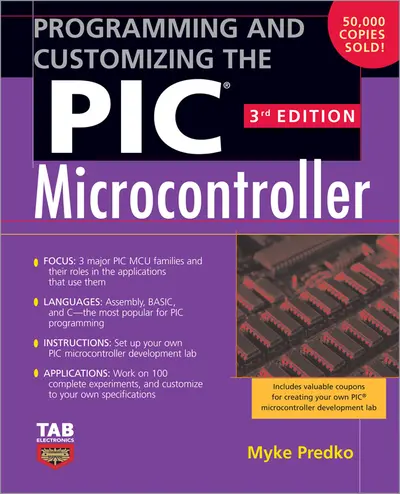My Account Details

ISBN10: 0071472878 | ISBN13: 9780071472876

Step 1 . Download Adobe Digital Editions to your PC or Mac desktop/laptop.
Step 2. Register and authorize your Adobe ID (optional). To access your eBook on multiple devices, first create an Adobe ID at account.adobe.com. Then, open Adobe Digital Editions, go to the Help menu, and select "Authorize Computer" to link your Adobe ID.
Step 3. Open Your eBook. Use Adobe Digital Editions to open the file. If the eBook doesn’t open, contact customer service for assistance.
Publisher's Note: Products purchased from Third Party sellers are not guaranteed by the publisher for quality, authenticity, or access to any online entitlements included with the product.
MASTER PIC MICROCONTROLLER TECHNOLOGY AND ADD POWER TO YOUR NEXT PROJECT!
Tap into the latest advancements in PIC technology with the fully revamped Third Edition of McGraw-Hill's Programming and Customizing the PIC Microcontroller. Long known as the subject's definitive text, this indispensable volume comes packed with more than 600 illustrations, and provides comprehensive, easy-to-understand coverage of the PIC microcontroller's hardware and software schemes.
With 100 experiments, projects, and libraries, you get a firm grasp of PICs, how they work, and the ins-and-outs of their most dynamic applications. Written by renowned technology guru Myke Predko, this updated edition features a streamlined, more accessible format, and delivers:
- Concentration on the three major PIC families, to help you fully understand the synergy between the Assembly, BASIC, and C programming languages
- Coverage of the latest program development tools
- A refresher in electronics and programming, as well as reference material, to minimize the searching you will have to do
WHAT'S INSIDE!
- Setting up your own PIC microcontroller development lab
- PIC MCU basics
- PIC microcontroller interfacing capabilities, software development, and applications
- Useful tables and data
- Basic electronics
- Digital electronics
- BASIC reference
- C reference
- 16-bit numbers
- Useful circuits and routines that will help you get your applications up and running quickly
Chapter 1 - Microcontrollers
Chapter 2 - The Microchip PIC Microcontroller
Part 2: Setting up your own PIC Microcontroller Development LabChapter 3 - Programmer PCB
Chapter 4 - Software Development Tools
Part 3: PIC MCU Basics
Chapter 5 - PIC MCU Processor Architecture
Chapter 6 - The PIC Microcontroller Instruction Set
Chapter 7 - The Configuration Register
Chapter 8 - Basic Operating Features
Part 4: PIC Microcontroller Interfacing Capabilities
Chapter 9 - PIC MCU Optional Hardware Features
Chapter 10 - PIC MCU Application Design Issues
Chapter 11 - PIC MCU Hardware Interfacing
Chapter 12 - Practical PC Interfacing
Chapter 13 - PIC Microcontroller Program Memory Loading
Part 5: PIC Microcontroller Software Development
Chapter 14 - Microchip MPLAB IDE
Chapter 15 - Assembly Language Software Techniques
Chapter 16 - Macro Development
Chapter 17 - Designing your own PIC Microcontroller Applications
Chapter 18 - Debugging your Applications
Chapter 19 – Emulators
Part 6: PIC Microcontroller Applications
Chapter 20 – Demonstrations
Chapter 21 - Projects
Chapter 22 - Real Time Operating Systems
Chapter 23 - In Closing
Appendix A: Resources
Appendix B: PIC MCU Summary
Appendix C: Useful Tables and Data
Appendix D: Basic Electronics
Appendix E: Digital Electronics
Appendix F: BASIC Reference
Appendix G: C Reference
Appendix H: 16 Bit Numbers
Appendix I: Reuse, Return and Recycle
Need support? We're here to help - Get real-world support and resources every step of the way.